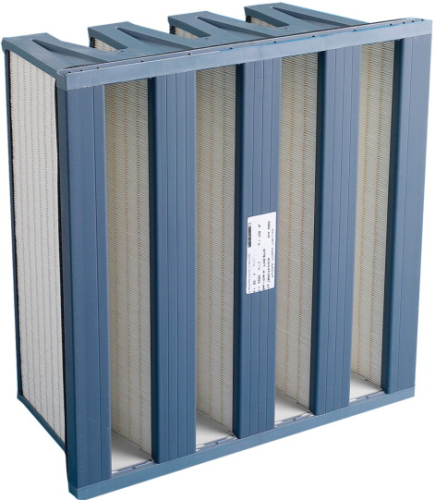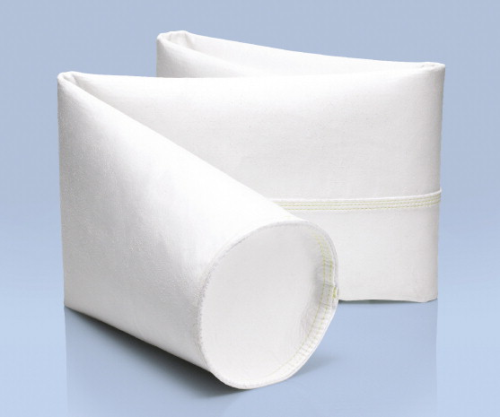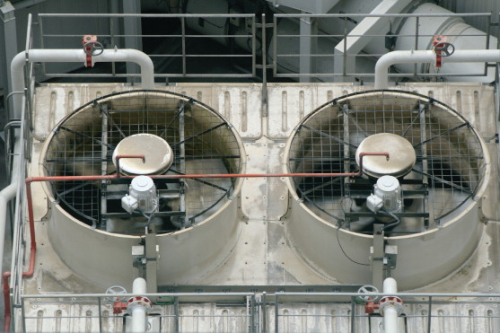


In many respects, air and other gas filtration represent the less exciting part of the filtration business, by comparison with liquid filtration. Certainly it is much smaller: “dry” filtration makes up only around 15 % of the total filtration market, about one sixth that of “wet” filtration. However, its applications are to be found throughout almost every aspect of human endeavour, some being critical to safety or economic success, and many of which are growing in importance.
In terms of equipment types employed, a much wider range is used for liquid filtration than for gas; in fact, almost all gas filtration is achieved by means of some kind of replaceable filter element, held in an appropriate housing. A significant proportion of liquid filtration takes place in a wide range of complex process filters or centrifuges, where the feed suspension is reasonably concentrated; there is no real equivalent to this in gas filtration (although some baghouses do handle quite concentrated feeds) – most high concentration gas suspensions are separated first in a cyclone.
It follows that most gas phase filtration is used for the removal of a small quantity – 1% or often much less – of suspended solid particles or liquid droplets from a continuous gas flow. This is mainly a clarification duty, and the system requirement is usually that the downstream gas flow be as free from contamination as possible. One of the main themes in the development of gas phase filtration is that the requirement for freedom from contaminating material has been, and continues to be, more demanding with each passing year. Where the separated material is valuable, then the increased efficiency is mainly a matter of process economy (i.e. reduced losses), but the driving forces are more often those of environmental protection and personal health and safety, to keep atmospheric air, and internal air, quality as high as possible.
Among the applications for air and other gas filtration are:
• respirators and breathing air systems;
• compressed air production, typically for pneumatic and hospital air systems;
• critical working atmosphere venting and control, including provision of clean rooms;
• general building ventilation and air conditioning, including prevention of “sick building syndrome”;
• vehicle cabin air filtration, including atmosphere control in buses, trains, airplanes, and passenger ships;
• mobile engine air intakes and exhausts (especially for diesel engines);
• large stationary engine air intakes, for diesel and gas engines, and especially gas turbines, set up on-shore or mounted on offshore platforms;
• process air cleaning, where the air is to be a process input, or coolant;
• process exhausts, especially where these come from chemical reactions, such as ore roasting, or heating furnaces, i.e. where the exhausts are hot; and
• demisting of gas streams free of water or oil droplets.
Each of these types of application for air or gas filtration can have their own particular features, which impact upon the separation process. Thus, it is vital to remove pathogenic viruses from airplane cabin air, especially with long-distance flights, to prevent disease transfer. The design of working spaces must take into account the need to prevent entry of contaminants from the surrounding atmosphere, and also to prevent discharge of hazardous materials from within the space. Gas turbines have become very large consumers of ambient air for combustion, which must be as free as possible of abrasive solid particles to protect the turbine blades. The need to be able to treat hot gases, possibly chemically active, presents major design problems, especially as the exhaust temperatures keep rising.
One application of growing importance, which particularly involves gas filtration, is the use of filters that can also adsorb or destroy one or more of the constituents of the gas. These combination filters employ a chemically active agent embedded in the filter medium material, the most common of which is activated carbon, as an adsorbent. There are also bactericidal and oxidising additives, which can make a very useful processing tool.
Structure of the business
As has been suggested, the key to successful air or gas filtration is to select the right filter element for the job to be done, and to mount it in a proper housing. Not surprisingly, therefore, the bulk of the companies involved in this business make filter media, or the filter elements derived from the various types of media, where the elements are intended to be housed in the company's own housings, or the housings made by others. The market leaders (Pall, Parker-Hannifin, Donaldson, Cummins, GE, etc) are suppliers of elements, housings and filter systems using them, while Freudenberg, Kimberly-Clark, Johns-Manville and Ahlstrom are major suppliers of bulk media.
In common with other segments of the filtration business, there has been some consolidation among the companies serving the gas filtration segment. Perhaps the most significant was the sale by SPX of its SPX Air Filtration division (with well-known brand names such as Vokes-Air, Scandfilter, Atex-Filter, and Industri-Filter), to a private equity company, Riverside. This triggered Riverside's sale of Universal Air Filter to another equity holding company, Thompson Street. Other private equity deals have seen the purchase of Polyester Fibres by Empire Investment Holdings, of Norit by Doughty Hansen, and of Jacob Helm & Sons STA by L D Equity.
Operating company purchases have seen AAF bought by Daikin Industries, Fabriano by Ahlstrom, Griffin Filters by Cemtrex, Universal Silencer from Cummins by Stirling Group (set up specifically for the purchase), OMI by Ingersoll Rand, Arboga-Darenth by Nederman, Precisionaire from Flanders by Superior Fibers, Amafilter by Mahle Filtersysteme, and Western Filter by Donaldson. The present economic situation may make cash for such purchases more difficult to find – but, at the same time, may create some bargain possibilities.
Equipment development
The two most common forms of gas filter are the cylindrical cartridge or bag, in a cylindrical housing, and the “flat” panel filter, mounted in a dividing wall or plenum chamber. In numerical terms, almost as commonly used must be the mobile engine air intake filter, normally in the form of a flat circular array of pleated filter medium, with pleats as deep as the thickness of the element.
The filter bag is used singly, or side-by-side in duplex formation, in cylindrical housings, or in arrays of many bags in a large cylindrical vessel as housing, in the traditional baghouse arrangement. The single or duplex form is more commonly used for liquid filtration, but the baghouse is found in many industries as the main filter for process and power generation exhausts. The gas flow is through the bag from outside to in, so that separated solids accumulate on the outside, from which they can be blown by a reverse pulse of compressed air. Although generally giving way to nonwoven media, woven fabrics still have an important role in baghouses because of their ability to flex somewhat during the reverse pulse, and so break the accumulated cake of solids, allowing it to fall away from the bag. Apart from the gradual move from woven to nonwoven media, the main development in bag filters has been their return to widespread use once seamless construction had been developed – there having been problems with oversize holes at the seams. Another important development for the bag filter is its availability in membrane material form – such as Du Pont's HMT bags.
The filter cartridge, whether yarn wound, bonded fibre (or granules), or pleated sheet in construction, has taken some of the filter bag's share of the gas filtration market, mainly because of its ability to offer finer levels of filtration – which is a demand trend that is as important in some gas filtration applications as it has become in liquid filtration. This trend is also leading to the use of membrane media in pleated cartridge applications. The cartridge is used quite a lot as a strainer in critical air filtration applications, especially compressed air production, but numerically is more common in baghouse uses.
The growing need to be able to filter hot exhaust gases has led to the production of a range of temperature resistant filter elements. Where the temperature is not that far above 100°C then some thermoplastic media can be used, especially the fluorinated materials such as PTFE. For higher temperatures, wire mesh is the material of choice, especially multi-layer sintered mesh – although such media are also used where the gas is corrosive or the suspended solids are abrasive.
The most important development for hot gas filtration has been the ceramic filter element. Most commonly this is in the form of a tube, closed at one end, with the other end sealed into a tube sheet, from which it hangs (like an inverted candle). Of growing importance are the media made from ceramic fibre, also as a porous tube, but now more flexible than the rigid candle and so much more resistant to fracture in use. These ceramic media are now widely used in multi-element housings, for dealing with hot, dusty furnace exhausts.
A development of a very different kind for hot gas filtration is the use of packed beds of inert mineral granules, acting in the same way as the deep sand filter used for water clarification. Moving bed systems are now quite common for this purpose, in which the filtration occurs as the solids move down through a separation zone, to be swept away by a carrier gas stream, from the base of this zone to an upper cleaning zone.
Bulk air cleaning systems
In volume terms, the greater part of air filtration is probably undertaken by the panel filters used to protect building ventilation systems, and the internals of large engines, especially gas turbines. These take the form, usually, of a rectangular frame, carrying some filter medium, which is fitted into a matching space in a dividing wall between the ambient air and the required clean zone. The filter medium in its simplest form is a thin pad of nonwoven material, but this has only limited capacity (for air flow and particle retention), and more often takes the form of a layer of pleated sheet material, or of a set of pockets protruding backwards away from the front of the frame, or, most recently and of rapidly growing occurrence, the V-block panel formed of sets of V-shaped zones whose sides are made of smaller panels of filter media made of mini-pleats.
These panels are made to a small set of standard sizes, so that supplies are easily interchangeable, and they are offered by their manufacturer in grades matching the HEPA/ULPA and ASHRAE standards. The media are available in a wide range of materials, with much design ingenuity involved in ensuring the pleated material is effective across its total surface, even in the pinched spaces near to the folds.
Of special note in the context of ventilation filters is the cabin air filter, to be found everywhere nowadays in vehicles and other transportation systems. Such filters are fitted to agricultural tractors to protect the driver from soil particles, in even the cheapest automobiles, to protect the driver and passengers from pollen and diesel fuel residues, and especially in enclosed systems such as airplane cabins, through which air is circulated and where removal of bacteria and viruses is vital. Considerable ingenuity is required of the vehicle designer to fit adequate filtration units into what may be limited and awkward spaces.
The importance of the filter medium has been stressed, as the basis for successful gas filtration, and an important development here is the availability of materials with a density gradient across the thickness of the medium, even though this is quite thin, as with the “Intrepid” media from Kimberley-Clark
Energy conservation
The pressure drop in the gas stream as it flows through a filter represents an energy loss, which has to be made up by the overall system. This is especially true in the large volume applications, such as gas turbine air intakes and process exhausts. Quite apart from the economic implications of this energy loss, there are strong pressures on all industrial activities to use as little energy as possible: an efficient programme of energy conservation may well be as important on the global scale as developing a new source of renewable energy.
In the case of filtration, this drive to more efficient use of energy directly opposes the major driving force represented by the need to provide ever-finer degrees of separation. This dichotomy is not easily resolved, since filter media that separate more efficiently usually need higher pressure drops to do so. Much development activity is being put into the production of media with lower pressure drops, such as the membrane materials formed from a surface layer of fine fibres, such as Donaldson's “Ultra-Web” and the “Nanoweb” media supplied by Hollingsworth & Vose.
A significant number of new product announcements now include words like “energy saving” or “very low resistance to flow”.
Ken Sutherland has managed Northdoe Limited, his process engineering and marketing consultancy, for over 30 years. Northdoe is largely concerned with the marketing and technology of filtration and related separation processes. He has written numerous articles for this journal and for its sister publication Filtration Industry Analyst, as well as four books on separation processes, most recently an A to Z of Filtration and the fifth edition of the Filters & Filtration Handbook, both for Elsevier.




